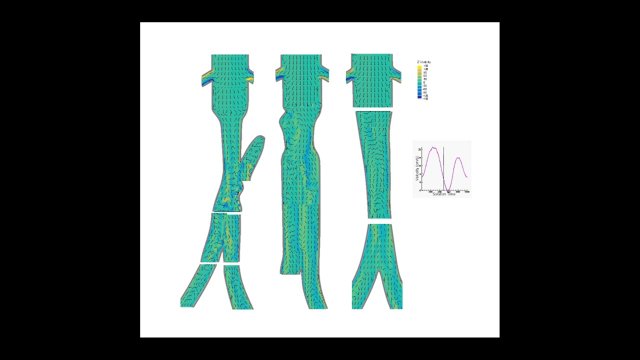CAR Project
This project is about the in vitro assessment of hemodynamics in customized aortic repair (CAR) developed by TripleMed (TripleMed B.V., Maastricht, The Netherlands) in the treatment of abdominal aortic aneurysm (AAA). The diseased aortic wall is excluded from the flow lumen by a complete sealing of the aneurysm with a non-cross-linked liquid polymer. An endovascular balloon excludes the aneurysm from the circulation during the filling with polymer. This percutaneous technique was tested in polyester aneurysms without bifurcation implanted in porcine, with promising results. The balloon concept provides a large degree of freedom during positioning, especially when reconstruction the aortic bifurcation/flow splitter, making CAR broadly applicable and suitable for complex and complex AAAs.
During this project three types of balloon configurations have been examined, a cross-configuration and two parallel-configurations. Focus was on the hemodynamically most favorable configuration in terms of flow velocities, vorticities, recirculation, (oscillating) wall-shear stress and relative residence time, visualized with in vitro laser particle imaging velocimetry (PIV), in order to optimize clinical application for AAA treatment, including reconstruction of the aortic bifurcation.
The configurations were placed in a custom flow setup, as previously described by Groot Jebbink et al.1, a two-element Windkessel setup with a pulsatile flow (60 beats/minute, 90-120 mmHg, mean flow 1.6 l/min, range: 0.0-5.0 L/min). A blood mimicking fluid (BMF) based on water, glycerol and sodium was used during flow experiments. Small fluorescent particles were added to the BMF for PIV measurements. A continuous wave laser was used to create a parallel beam that illuminated a streak of fluid. Perpendicular to the laser beam, a high speed camera (1000-3000 frames/second) captured the fluorescent signal emitted by the particles.
Customized aneurysm repair showed to be a potentially successful new solution of treating AAA. The differences in infrarenal velocities, complex flows and vortices around the crossing, the outflow and WSS, showed that the second parallel-configuration has favorable hemodynamics compared to the cross and first parallel configurations. However, it is advised to further investigate positioning accuracy for more complex geometry, since outcome depends highly on balloon conformation in the proximal neck.
1. Groot Jebbink E. Innovation in aortoiliac stenting: an in vitro comparison. MSc Thesis. 2014. doi:10.1117/12.2042865.

